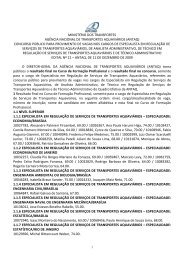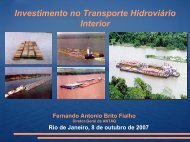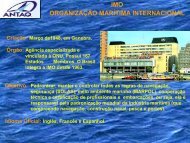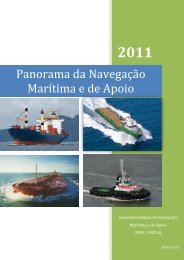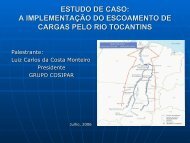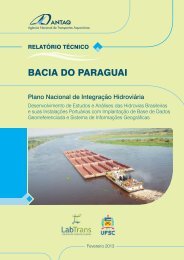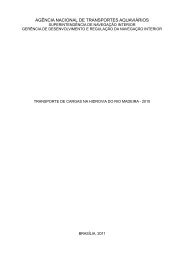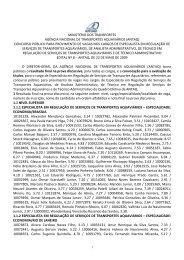Waterway Panorama - Antaq
Waterway Panorama - Antaq
Waterway Panorama - Antaq
You also want an ePaper? Increase the reach of your titles
YUMPU automatically turns print PDFs into web optimized ePapers that Google loves.
INLAND NAVIGATION<br />
Completion of Tucuruí Locks<br />
Rivers cross the Center-West and Amazon<br />
regions, forming the largest drainage area<br />
entirely within the national territory, coupled<br />
with their strategic role with great potential<br />
for hydropower, agriculture, mining, navigation,<br />
and power generation. The basin includes<br />
the states of Pará, Tocantins, Goiás, Mato<br />
Grosso and Maranhão, in addition of the Federal<br />
District.<br />
This area is distinguished by high production<br />
of maize, rice, soybeans and sugar cane, among<br />
other products, with great potential for increased<br />
production. The basin formed by the rivers gathers<br />
grain producing areas and includes the livestock<br />
and mineral sectors, with extensive production<br />
of aluminum, asbestos, bauxite,<br />
limestone, copper, iron ore, and nickel. The agricultural<br />
potential of the waterway joins the multimodal<br />
network, where the waterways are part of<br />
the Carajás and North-South railways, bringing<br />
goods to the Port of Itaqui in Maranhão, and Vila<br />
do Conde, in Pará, and maritime transport.<br />
The construction of Tucuruí locks was initiated<br />
in 1981 and halted in 1989. Resumed in September<br />
1998, the works were again interrupted<br />
in December 2002. The last of the work was resumed<br />
in July 2004. In 2007, the project was included<br />
in the Growth Acceleration Plan – PAC,<br />
with the allocation of R$815 million between<br />
2007 and 2010 for the completion of works.<br />
To bridge the gap of 39 meters from the lake<br />
formed by the busbar and the river, 6.5km below,<br />
the Tucuruí presents a general arrangement<br />
of structures with two locks connected by an intermediate<br />
channel which allows for the crossing<br />
and maneuvering of vessels, thus enabling<br />
the fully independent operation of the locks.<br />
This set bridges the gap on site and is developed<br />
on the left bank of the Tocantins River,<br />
starting in the reservoir with Lock 1, embedded<br />
in the earth dam by concrete walls and ending<br />
on Lock 2 and the downstream approach channel<br />
on the Tocantins River, located near the city<br />
of Tucuruí.<br />
97



